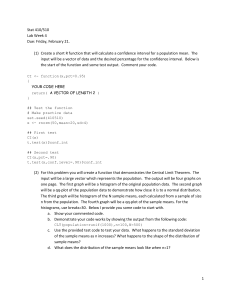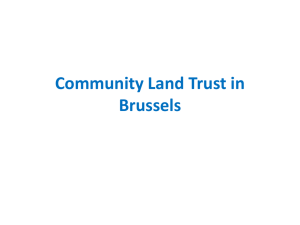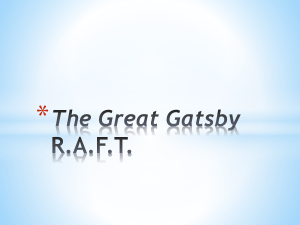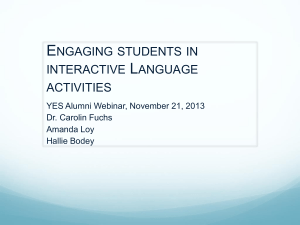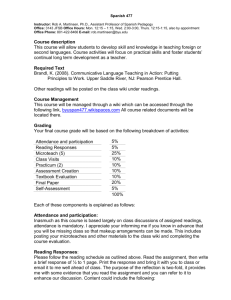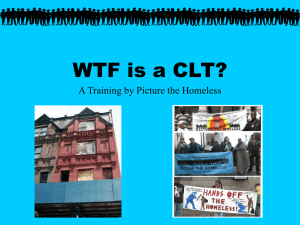CLT Framework
advertisement
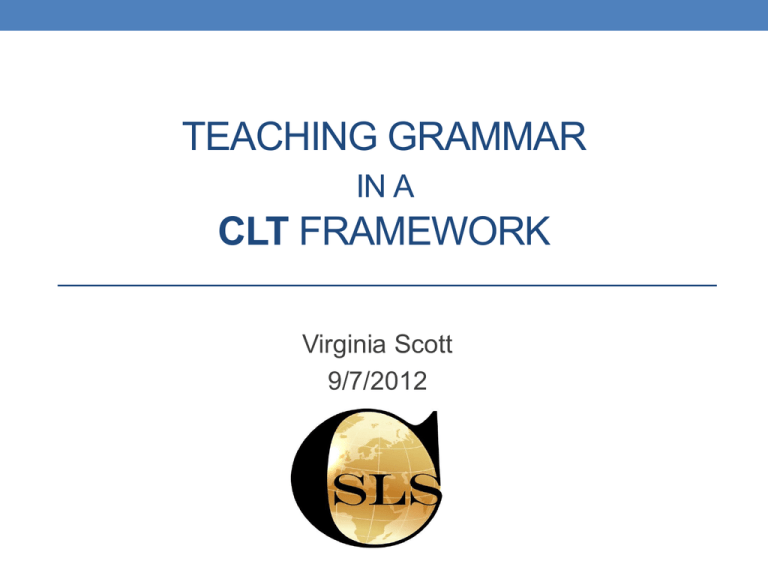
TEACHING GRAMMAR IN A CLT FRAMEWORK Virginia Scott 9/7/2012 What is Communicate Language Teaching? Theory: The primary function of language is communicative. Goal: Use real-life situations that necessitate communication. Approach: Meaning before form Learning centered Listen to Abrams on FLTM web site. Where is grammar in a CLT approach? CONTEXT is the overarching organization of a CLT lesson. For example: “Today we will be talking about things we like to do and things we do NOT like to do.” GRAMMAR is NOT the overarching organization of a CLT lesson. For example: “Today we will learn the present progressive to express preferences.” Scott’s O T P C OTPC can help you to BE ORGANIZED: Overview Teach Practice Communicate OVERVIEW Target language only!! • Introduce the topic • Set the CONTEXT • Use REAL language only • Avoid use of “grammar talk” (metalanguage) • Suggest the PURPOSE for the lesson. TEACH 90% in target language Present the target structure according to a decided plan: • Oral vs. written • Use of visuals (text, board, technology) • Personalization / relevance to students’ lives PRACTICE L1 ONLY for directions ORAL /CHORAL PRACTICE: Choral repetition Form-focused practice Move from form-focused practice (one possible answer) to openended practice (multiple possible answers). [Correct pronunciation and grammar errors in this phase.] PRACTICE WRITTEN PRACTICE: • Have students write during class • note taking • reinforcement after oral/choral practice • Use writing as a pre-speaking exercise • Spelling tests • Dictation PRACTICE SUMMARY: • VARY the kinds of practice for each structure • oral vs. written • individual vs. pair vs. group work • • • USE the exercises in your text books Correct errors: pronunciation & grammar QUESTIONS? What kinds are appropriate??? COMMUNICATE Students express personal meaning. Meaning is more important than form. There is no single correct answer. • Give clear directions (L1 may be important) • Allow for pre-speaking preparation (writing, thinking) • Provide sufficient linguistic support from book, on board, etc. • Use small group work IF it’s appropriate SAMPLE LESSON OVERVIEW Today we will be talking about things we like to do and things we do NOT like to do.” TEACH (Listen) going to the movies eating pizza watching TV talking to friends riding a bike dancing hiking reading a book sleeping late TEACH (Listen and repeat) I enjoy going to the movies. I like eating pizza. I hate watching TV. I really like talking to friends. I don’t like riding a bike. I love dancing. I like hiking. I really don’t like reading a book. I love sleeping late. TEACH (Listen and note if what you hear is TRUE or FALSE for you) 1) TRUE ____ 2) TRUE ____ 3) TRUE ____ 4) TRUE ____ 5) TRUE ____ 6) TRUE ____ 7) TRUE ____ 8) TRUE ____ FALSE ____ FALSE ____ FALSE ____ FALSE ____ FALSE ____ FALSE ____ FALSE ____ FALSE ____ TEACH (Read and indicate the response that best fits you.) When I have free time I enjoy ___ watching TV. ___ reading a book. ___ talking to friends. When I am hungry I prefer ___ going out to a restaurant. ___ cooking dinner at home. ___ getting fast food. When I go out with my friends we do not like ___ going to the movies. ___ sitting in a bar. ___ dancing in a club. TEACH What have we learned? Expressions for indicating what you like: I like I really like I enjoy I love Expressions for stating what you dislike: I don’t like I really don’t like I hate TEACH What have we learned? • You can add “ing” to verbs: • You can state preferences before the “ing” verb: I like going / I hate eating / I enjoy dancing PRACTICE (Turn to your friend and exchange information.) When I have free time I enjoy ___ watching TV. ___ reading a book. ___ talking to friends. And you …? When I am hungry I prefer ___ going out to a restaurant. ___ cooking dinner at home. ___ getting fast food. And you …? When I go out with my friends we like ___ going to the movies. ___ sitting in a bar. ___ dancing in a club. And you … ? PRACTICE (Turn to your friend and exchange information.) When I have free time I don’t like ___ watching TV. ___ reading a book. ___ talking to friends. And you …? When I am hungry I hate ___ going out to a restaurant. ___ cooking dinner at home. ___ getting fast food. And you …? When I go out with my friends we really don’t enjoy ___ going to the movies. ___ sitting in a bar. ___ dancing in a club. And you … ? COMMUNICATE Fill in the blanks below and be prepared to share the information. Name ____________________ I like eating _______________________________. I love drinking _____________________________. I enjoy watching ___________________________. I prefer reading _____________________________. I do not like going _____________________________. COMMUNICATE For homework, write a paragraph about what you generally like and don’t like doing when you have free time. Use the structures we practiced in class today. Summary … CLT is an approach that favors a focus on MEANING before FORM. If possible, teach grammar structures INDUCTIVELY. (present examples then guide students to discover the rule) The OTPC approach helps you be organized as you think about CLT. Accuracy is a focus in the PRACTICE phase. Accuracy should not be a focus during the COMMUNICATE phase. The classroom should be used for activities that cannot be done elsewhere.

